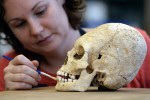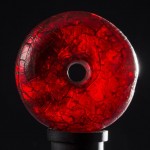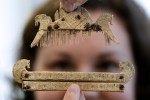 An archaeological survey in advance of construction in Obernai, in the northeastern French province of Alsace, has unearthed nearly 7,000 years of history, from the Neolithic through the Merovingian periods. The oldest section of the 7.5-hectare site is the south-eastern zone where a Neolithic burial complex dating to 4900 – 4750 B.C. was discovered. There are 20 people buried there. Another Neolithic burial ground, this one dating to 4750 B.C. at the earliest, revealed 15 corpses buried with jewelry — necklaces of limestone beads, weirdly large stone armbands — flint tools and pottery. It’s the latter that marks these graves to the waning days of the Grossgartach culture, a period of transition in Stone Age Europe that up until now has been poorly represented in the archaeological record of Alsace.
An archaeological survey in advance of construction in Obernai, in the northeastern French province of Alsace, has unearthed nearly 7,000 years of history, from the Neolithic through the Merovingian periods. The oldest section of the 7.5-hectare site is the south-eastern zone where a Neolithic burial complex dating to 4900 – 4750 B.C. was discovered. There are 20 people buried there. Another Neolithic burial ground, this one dating to 4750 B.C. at the earliest, revealed 15 corpses buried with jewelry — necklaces of limestone beads, weirdly large stone armbands — flint tools and pottery. It’s the latter that marks these graves to the waning days of the Grossgartach culture, a period of transition in Stone Age Europe that up until now has been poorly represented in the archaeological record of Alsace.
There are some Bronze Age artifacts, but the next major evidence of occupation on the site dates to the Gallic period, starting around 450 – 350 B.C. Again it’s burials, but very curious ones. Round storage pits contain human and animal remains in various combinations. One grave contains the bones of two children and several dogs. Another features the skeletons of a dog and a sheep or goat. A third contains the partial remains of a buck, including his head and handsome rack. A fourth holds a shield. There’s evidence of habitation there too, the remains of dwellings. Archaeologists believe the burials indicate this was a site of religious significance, perhaps a shrine.
 Adjacent to these burials is a more recent Gallic enterprise, a prosperous farm from 150 – 30 B.C. which covers nearly two acres of the site. It is bounded by a dug enclosure which in its time was strengthened by earthenware embankments, now long gone.
Adjacent to these burials is a more recent Gallic enterprise, a prosperous farm from 150 – 30 B.C. which covers nearly two acres of the site. It is bounded by a dug enclosure which in its time was strengthened by earthenware embankments, now long gone.
[The Gallic farm] has two doors built into its corners, one of which is covered with a monumental porch. Inside the enclosure, there are building remains, storage pits and many artefacts from the Final La Tene period (150 to 130 BC). These artefacts (fibulae, glass ornaments, pottery, amphorae, coins, etc.) show the importance of this farm and the wealth of its owner.
The Gallo-Roman period is attested to by the remains of a bathing complex and by sandstone columns that appear to have been deliberately discarded, thrown broken into a pit.
 It’s the Merovingian (5th-8th century A.D.) finds that take my cake, however. In a necropolis containing 18 west-east burials, one woman was found buried with the richest grave goods. Gold pins kept a garment together over her chest and she had two chatelains, chains suspended from a belt that held practical objects for household use. The objects she carried where a silver mirror, beads of glass and amber, a set of tweezers and an earscoop (a surprisingly popular device throughout the ages) for her emergency grooming needs. Also buried with her was a triangular comb made out deer antler decorated with geometric patterns that reminds
It’s the Merovingian (5th-8th century A.D.) finds that take my cake, however. In a necropolis containing 18 west-east burials, one woman was found buried with the richest grave goods. Gold pins kept a garment together over her chest and she had two chatelains, chains suspended from a belt that held practical objects for household use. The objects she carried where a silver mirror, beads of glass and amber, a set of tweezers and an earscoop (a surprisingly popular device throughout the ages) for her emergency grooming needs. Also buried with her was a triangular comb made out deer antler decorated with geometric patterns that reminds me of that 3rd century Germanic one with the runes.
me of that 3rd century Germanic one with the runes.
The silver mirror is of a design common among the Alano-Sarmatian peoples who left their North Caucasus homelands heading west under pressure from invading Huns in the late 4th century and 5th centuries. What really identifies her as an Alan is her ovoid skull, a result of intentional cranial deformation. The fashion for binding infants’ heads with straps or cradleboards to elongate and flatten their skulls wasn’t just a Mesoamerican phenomenon, although they may be its most well-known proponents today. Intentional cranial deformation was used extensively in Europe, Asia and Africa as well. The Alan version of the practice used circular bandages wrapped around babies’ heads to flatten front and back of the skull with equal pressure. Here’s a facial reconstruction of a Hunnish woman with this kind of cranial deformation.
This practice distinguished the elites and affirmed their social status. Similar graves, which are usually isolated, have been discovered in Northern Gaul, Germany and eastern Europe. They are accompanied by abundant grave goods. They thus appear to be the graves of high dignitaries and their families, of eastern origin, incorporated into the Roman army during the “great migrations”. The Obernai necropolis is one of the few large groups of discovered in France. It is the first evidence of the presence of an eastern community over a long period of time in Alsace at the end of the Roman Empire.
INRAP (the National Institute of Preventive Archaeological Research) has a gallery of (sadly small) photos from the excavation that you can browse here.
The photos on the INRAP site are actually really nice. Clear, taken real close so you can see a lot of detail. Thanks for providing the link!
to spooky :skull:
Hi, did Ptolomeans also had their skulls deformed due circular bandaging?
Alans, really? Rather fashion that happend all over the place. And the material? Trade, connection, communication. Thas what is happening in transformation period…after the so-called ‘Fall of Rome’ (and don´t read Heather!)… due to representational meanings and sort of. Try and read: Brather for understanding the ethnic interpretation. Halsall got it right as well.
Good luck with Archaeology